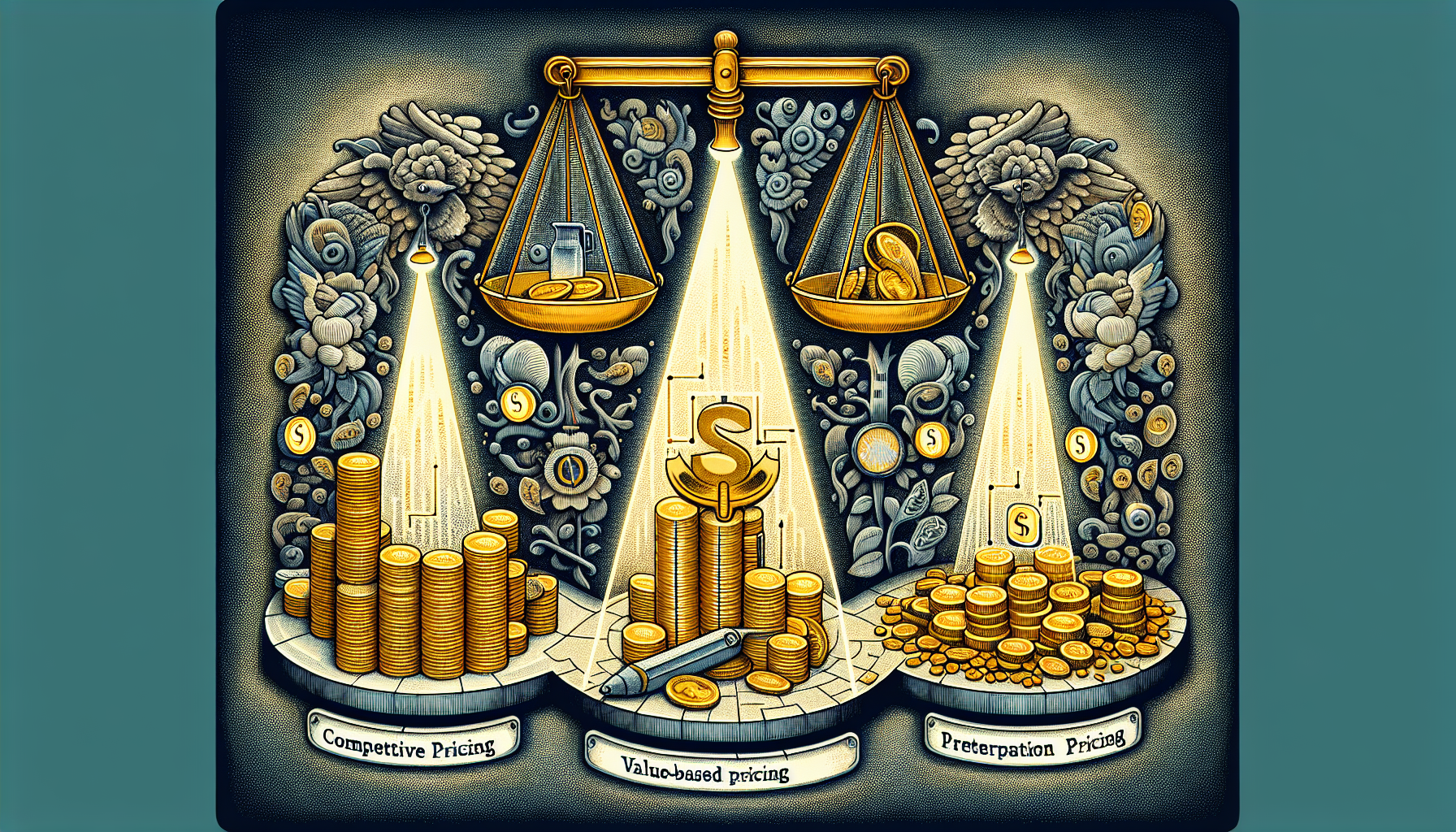
Master Your Margins: Effective Price Strategy Techniques for Maximum Profit
Selecting a suitable price strategy is a critical step for businesses aiming to maximize their profit margins and gain market advantage. This guide explores various pricing methods, insightful for startups to established entities, and equips you with tactical know-how to effectively apply these strategies, ensuring they align with your market goals and customer expectations.
Key Takeaways
-
An effective pricing strategy is essential for profit optimization, providing competitive advantage, and driving long-term business success, focusing on factors like costs, value delivery, and consumer perception.
-
Competitive pricing should account for competitor analysis and market positioning, while value-based pricing focuses on pricing products based on perceived value to the customer.
-
The application of various pricing strategies such as penetration pricing, psychological pricing, dynamic pricing, and discount pricing should be tailored to the business model, product characteristics, and market conditions for maximum effectiveness.
Decoding Price Strategy: The Bedrock of Business Success

The world of commerce spins around the axis of pricing strategy. It is the process of setting prices for products and services, inherently indicating the value placed on the brand, product, and customers. This strategy can be your magic wand, capable of transforming your business’s revenue patterns. It’s often more potent in driving business growth than customer acquisition. It’s no ordinary strategy, but an art that requires you to evaluate your business specifics, taking into account factors such as costs, demand, and business goals to ensure alignment with value delivery. This strategic pricing game has the power to shape consumer perception of a product’s value and influence your brand identity. With effective communication, you can enhance your customers’ willingness to pay by up to 20%.
But what defines this crucial pricing strategy, and why is it so significant? Let’s delve deeper.
What Defines a Pricing Strategy?
A pricing strategy isn’t just a tag on a product. It’s a company’s strategic approach to setting the cost for its products or services. It is a compass that directs your company’s market position and bolsters trust among clients. But beware, an incorrect pricing can deter your intended customer base and fail to accurately convey the value of your product. So, it’s not just about numbers and calculations. It’s a crucial player in whether your company reaches its overall goals or not.
From competitive pricing to a value-based approach, from penetration pricing to cost-plus strategy, there’s a spectrum of common pricing strategies to choose from. Selecting the best pricing strategy can be the difference between floundering in a sea of competition or sailing smoothly towards market dominance.
Significance of an Effective Pricing Strategy
A well-crafted pricing strategy is like a key that directly unlocks profit margins. It defines the best possible price point to cover costs and maximize profits. It’s not just about setting the price tag; it’s about understanding the customer perception of value alongside competitiveness. It’s about ensuring that you are not leaving money on the table. By achieving the right balance between cost and value, you can optimize your profit margins through strategic pricing.
But that’s not all. Effective pricing strategies can provide businesses with a competitive advantage by enabling them to:
-
differentiate their offerings in the market
-
attract and retain customers
-
increase market share
-
maximize profits
-
drive long-term business success
So, an effective pricing strategy is not just a tool for profit optimization; it’s a strategic weapon for achieving competitive advantage and driving long-term business success.
Crafting a Competitive Pricing Strategy

In the battlefield of business, a competitive pricing strategy can be your trusted armor. It involves setting prices in accordance with competitors’ prices, essentially based on what the competition is charging. It’s like playing a game of chess, where understanding the market and the competitors’ strengths and weaknesses can help you make your next winning move.
Whether your product or service is similar to those of direct and indirect competitors, a quick analysis can inform your competitive pricing strategy. But beware, relying heavily on competition-based pricing models can have its drawbacks, including dependence on competitors’ research, which may not always be applicable. So, while it’s important to consider competitors’ pricing, remember to set your prices based on your unique brand identity.
Let’s dive deeper into this strategy and explore how to analyze the competitor pricing landscape and position your prices in the market.
Analyzing Competitor Pricing Landscape
Imagine you are a soldier on a reconnaissance mission. You are studying the landscape, comparing your position to your enemies’, identifying both direct and indirect threats. Sounds intense, right? Well, that’s exactly what analyzing competitor pricing feels like in the business world. The competition-based pricing strategy uses the existing market rate as a benchmark, understanding that even slight price differences can be a deciding factor for customers in saturated markets.
A thorough understanding of competitors’ pricing can reveal opportunities for your business to adjust its own prices to increase market share. You can also use this knowledge to implement a penetration pricing model, successfully positioning your product at a significantly lower price point initially.
Positioning Your Prices in the Market
After deciphering the competitor pricing landscape, the next step is to position your product prices strategically in the market. This is like setting up your chess pieces on the board, ready for the game. Competitive pricing enables businesses to position their product pricing strategically relative to competitors, either pricing products slightly below, matching, or slightly above the competition. By analyzing the market, businesses can determine whether to position their prices above, match, or below the market standards.
Effective use of competitive pricing strategies can assist businesses in increasing their market share, preventing profit losses, and monitoring their market position effectively. Properly implemented pricing strategies can serve as a growth lever, facilitating revenue increases when customers perceive the value offered and are willing to pay higher prices.
The Art of Value Based Pricing

Welcome to the art gallery of business strategies, where value-based pricing is the masterpiece that captures everyone’s attention. Value-based pricing is the strategy of setting prices based on the perceived worth of the product or service to the customer, which can be particularly effective for unique or highly valuable products and affects the product’s perceived value and exclusivity. It’s like painting a picture where the colors represent the customers’ perceptions of your product’s value. The more vibrant and appealing the colors, the higher the willingness to pay.
But how do you understand these customer perceptions and implement a value-based pricing strategy? Let’s explore.
Understanding Customer Perceptions
Understanding customer perceptions in value-based pricing is like reading a book. Each page unveils a new layer of the customers’ psyche, revealing their perceptions of your product’s value. Identifying the specific benefits and outcomes customers seek, understanding the full value proposition of competitors’ offerings, and analyzing customer feedback are fundamental to establishing perceived value.
For successful product bundling, the focus should be on:
-
the overall experience and congruity of the bundle
-
the monetary value of individual items
-
feedback from customers on pricing to inform strategic pricing decisions
-
effective design to enhance the overall perceived value of the product
This approach can significantly increase customers’ willingness to pay.
Implementing a Value Based Pricing Strategy
Now that you understand your customers’ perceptions, it’s time to create your masterpiece with a value-based pricing strategy. Imagine you are an artist preparing for an exhibition. Your art is your product, and the price tag is the value you attach to it. Effectively conveying the value proposition to customers is vital when setting value-based prices. Clear communication about the product’s added benefits is essential for the customer to understand the value they receive.
Providing flexible payment options can assist in communicating a product’s value, making it more accessible while maintaining a premium image. A brand that successfully conveys a perception of high added value, such as Fashion Nova, enjoys greater liberty in setting pricing levels.
Penetration Pricing: Capturing Market Share

Penetration pricing is like a submarine dive into the depths of the market. It’s about starting with lower prices to disrupt the market, capture market share, and then gradually rise to the surface with increased prices once a substantial customer base is secured. It’s a calculated risk, like a new business willing to absorb early losses to disrupt established players and attract their customer base.
But how do you establish initial lower prices and scale up from low prices to market dominance? Let’s dive deeper into this strategy.
Establishing Initial Lower Prices
Embarking on a penetration pricing strategy is like entering a battlefield. Your weapon? Lower prices. These initial lower prices can act as a Trojan horse, disrupting the market, and capturing the attention of customers, who are then more likely to try your product or service.
This strategy is particularly effective in markets with low product differentiation and where the product or service is suitable for a mass market.
Scaling Up: From Low Prices to Market Dominance
Once you’ve infiltrated the market with lower prices, the next step is to scale up from low prices to market dominance. It’s like climbing a mountain. The initial climb can be steep and challenging, but once you reach the top, the view (or in this case, the market share) makes it all worthwhile. Companies like Netflix and Uber have mastered this strategy, gaining customer loyalty without significant price raises.
With the right strategy and execution, you too can reach the summit of market dominance.
Maximizing Sales with Psychological Pricing

Welcome to the world of psychological pricing, where science and commerce meet. This strategy targets human psychology to boost sales using techniques like the ‘9-digit effect’ and location and font adjustments. It’s like a magic trick, where understanding your audience’s motivations and desires can result in increased sales.
But what’s the psychology behind pricing endings, and how can you use strategic discounting to attract customers? Let’s delve into the fascinating world of psychological pricing.
The Psychology Behind Pricing Endings
The psychology behind pricing endings is like a hidden code that can influence consumer perception. Consumers perceive a greater savings between prices ending in .95 or .99 and round numbers, even if the actual difference is minimal. Prices ending in .95 or .99 often signify a discount to consumers. Consumers tend to pay less attention to the rightmost digits of a price, which makes prices ending in .99 seem less than they actually are.
Ending price points with a 9, such as $19 instead of $20 or $19.99, is a classic example of psychological pricing.
Strategic Discounting for Customer Attraction
Strategic discounting is like a magnet that attracts customers. By offering discounts on products or services, businesses can increase foot traffic, help offload unsold inventory, and attract price-conscious customers. Offering initial lower rates through discount pricing can convert new customers who may continue making purchases even after the discount period has ended. Selecting the right type of promotion, such as coupons, contests, or loyalty programs, that aligns with campaign goals and the interests of the target audience is crucial.
Marketing bundle deals effectively can lead to an increase in sales by promoting additional purchases of related products or services.
Dynamic Pricing Strategy: Adapting to Market Changes
Imagine being a chameleon in the business world, adapting your prices to blend with market and customer demand. Dynamic pricing is a flexible pricing strategy where prices change based on market and customer demand. This approach allows businesses to adjust their prices in real-time. Companies like Airbnb, Amazon, and Uber have leveraged this strategy to stay competitive and maximize profits.
But how do you leverage real-time data for pricing adjustments, and what does success look like in dynamic pricing? Let’s explore.
Leveraging Real-Time Data for Pricing Adjustments
Leveraging real-time data for pricing adjustments is like being a weather forecaster. You analyze current conditions to predict future trends and make informed decisions. In dynamic pricing, businesses analyze market demand to fine-tune pricing strategies. Companies like Uber and Shell use dynamic pricing to respond to real-time supply and demand, as well as other factors like:
-
route time
-
distance
-
traffic
-
cost variations
Dynamic pricing requires businesses to continuously revise their prices to reflect shifts in customer preferences and market conditions. Combining dynamic pricing algorithms with human oversight can result in:
-
Optimized pricing
-
Flexibility to adjust prices quickly
-
Increased competitiveness
-
Improved revenue and profitability
All within the boundaries of established business rules.
Case Studies in Dynamic Pricing Success
Success in dynamic pricing is like winning a gold medal in the Olympics. It requires strategic planning, meticulous execution, and continuous adaptation. Let’s look at a couple of champions in the dynamic pricing arena.
Airbnb’s ‘Smart Pricing’ mechanism automates rental pricing by taking into account current demand, seasonality, and unique characteristics of the property. It helps Airbnb hosts optimize their revenue by ensuring their rental prices are competitive during times of high demand and appropriately discounted during lower demand periods. The success of Airbnb’s dynamic pricing demonstrates how real-time market data can lead to improved revenue management and serve as an example for other industries considering dynamic pricing strategies.
Skimming Pricing Strategy: High Entry, Gradual Reduction
Price skimming is like a roller coaster ride. You start at a high point with high prices and then gradually lower them to reach a wider audience as demand reduces. It’s a thrilling strategy that can drive more revenue while demand is high and competition is low, allowing for recovery of sunk costs and potentially extending the product’s period of perceived novelty.
But how do you set a premium price at launch and navigate price reductions post-launch? Let’s jump on this roller coaster ride and explore.
Setting a Premium Price at Launch
Setting a premium price at launch is like making a grand entrance at a party. You want to make a statement, to stand out, to position your product as high-quality in the minds of consumers. The use of premium pricing strategies can lead to higher profit margins, form increased barriers to competitor entry, and elevate the brand’s overall value. But remember, premium pricing is most effective when the product offered is distinct, perceived as a luxury item, or has strong barriers to market entry such as patents or proprietary technology.
Navigating Price Reductions Post-Launch
After making that grand entrance with high prices, the next step is to navigate price reductions post-launch. It’s like a dance, where you need to maintain the rhythm and balance to ensure a smooth performance. Understanding the market and customer demand helps in planning the timing and magnitude of price reductions to maintain profitability. Effective communication of price reductions to existing and potential customers is crucial for sustaining brand loyalty and trust.
Monitoring sales trends and customer feedback following price reductions provides valuable insights for further price strategy adjustments. Companies that are flexible and responsive to market dynamics can successfully manage price reduction strategies by assessing new pricing’s impact on sales volume and profit margins.
Economy Pricing: Winning with Volume
Welcome to the world of economy pricing, where the mantra is “winning with volume.” Economy pricing involves pricing products low and gaining revenue based on sales volume, typically used for commodity goods with low production costs. It’s like a game of numbers, where the key to success lies in maintaining low operational costs to support the reduced profit margins.
But how can you balance low costs with high volume and target the price-conscious consumer? Let’s uncover the secrets of economy pricing.
Balancing Low Costs with High Volume
Balancing low costs with high volume in economy pricing is like walking a tightrope. You need to maintain a delicate balance to ensure success. Analyzing and reducing production costs is crucial to effectively implement economy pricing, which is typically used for commodity goods with low production costs, such as groceries or drugs.
Lower prices aimed at high volume sales can compensate for the lower profit margins that are inherent in an economy pricing strategy. By leveraging economies of scale, businesses can highlight their product advantages over competitors, achieving competitive pricing alongside higher sales volumes.
Targeting the Price-Conscious Consumer
Targeting the price-conscious consumer with economy pricing is like fishing with the right bait. You need to understand what attracts your target audience and offer exactly that. A brand’s identity should align with pricing strategies like economy pricing to effectively appeal to consumers focused on affordability. Economy pricing is appropriate for businesses that target a broad customer base sensitive to price fluctuations.
To maintain competitiveness in foreign markets, sellers may absorb shipping costs, which can reduce profit margins but potentially increase brand awareness. Ensuring the price of a product matches the expectations and affordability of the targeted customer segment is crucial for the success of the pricing strategy.
Harnessing the Power of Bundle Pricing
Bundle pricing is like a box of chocolates. It’s a package of varied delights that adds value to offerings and entices customers to purchase multiple products or services together, enhancing their perceived value and increasing sales. But how do you create attractive product bundles and market them to drive higher sales? Let’s unwrap the magic of bundle pricing.
Creating Attractive Product Bundles
Creating attractive product bundles is like crafting a beautiful gift basket. You need to select the right items that complement each other and present them in a way that appeals to your customers. Product bundling is a strategy to enhance customer value perception by offering complementary items together. When creating product bundles, selecting complementary items is essential to provide a cohesive and attractive offer to customers.
Including differentiators like speedy delivery, unique customer experiences, and exceptional customer support can significantly increase the value perception of the product bundle. Product bundles that are thoughtfully curated with complementary products and value-added differentiators can lead to higher customer satisfaction and sales.
Marketing Bundles to Drive Higher Sales
Once you’ve created an attractive product bundle, the next step is to market it effectively to drive higher sales. It’s like showcasing your gift basket to the world, making sure everyone knows about the amazing value it offers.
Here are some strategies to market your product bundle effectively:
-
Bundle complementary products, accessories, and spare parts that customers are likely to purchase together to create compelling offers.
-
Strategically place your bundles in stores or on e-commerce platforms to increase impulse buying.
-
Highlight the savings and benefits of purchasing the bundle compared to buying the products individually.
-
Use eye-catching visuals and persuasive copy to promote your bundle.
-
Offer limited-time promotions or discounts to create a sense of urgency.
By implementing these marketing strategies, you can maximize the sales potential of your product bundle.
Well-crafted promotional messaging that conveys brand values and highlights bundle benefits can help differentiate these offers from competitors. Offering quantity discounts, loss leader discounts, and seasonal discounts within bundles can meet diverse business and customer needs.
Selecting the Right Pricing Strategy for Your Business Model
In the vast universe of business strategies, choosing the right pricing strategy for your business model is like finding the North Star. It’s a guiding light that can lead the way to success. But the journey to this North Star involves evaluating business goals and target customers, and tailoring the strategy to your product or service.
So, let’s embark on this journey and discover the right pricing strategy and pricing method for your business model.
Evaluating Business Goals and Target Customers
The first step on your journey to finding the right pricing strategy is to evaluate your business goals and target customers. It’s like using a compass to navigate your way. Refining buyer personas helps businesses understand how different customer segments respond to pricing, which is crucial for tailoring the pricing strategy. Quantified personas and segments allow businesses to determine who to target and how to monetize and retain customers more effectively.
Knowing your ideal customer profile aids in making better pricing decisions, essential for both monetization and customer retention. It’s also crucial to ensure that target audiences have distinct willingness to pay when implementing a value-based pricing model.
Tailoring the Strategy to Your Product or Service
After evaluating your business goals and target customers, the next step is to tailor your pricing strategy to your specific product or service. It’s like crafting a bespoke suit that fits perfectly. Businesses can tailor their pricing to their products or services by understanding the characteristics and preferences of their ideal customers.
Dynamic pricing is not a one-size-fits-all strategy; for example, subscription and SaaS businesses may avoid it, as customers expect consistent expenses rather than fluctuating prices. Competitive pricing is essential in environments like eCommerce where platforms like Shopify implement competitive costs, often the same or lower than others to attract and retain customers.
Tiered pricing models offer different plans at varying prices, each providing a scale of features or usage volumes, catering to various customer needs and creating value at multiple levels. Providing customization options within product bundles can enhance customer satisfaction by allowing for personalization of purchases, aligning more closely with customer preferences and increasing perceived value.
Premium Pricing: The Luxury Perception
Welcome to the world of premium pricing, where luxury and exclusivity are the name of the game. Premium pricing is employed by companies to assign high price tags to their products, aiming to establish a perception of luxury, high-value, or exclusivity. Brands like Rolex, Tesla, and Gucci have mastered this strategy, positioning their offerings as desirable and high-end.
But how do you build brand prestige and sustain a premium price point? Let’s explore the world of premium pricing.
Building Brand Prestige
Building brand prestige with premium pricing is like crafting a luxury brand. It requires careful planning, meticulous execution, and a commitment to delivering high quality at all times. Aligning a brand’s price positioning with its perception, strategic market share goals, and the competitive landscape is essential for building a prestigious brand image. Premium pricing strategies that focus on delivering products at a higher price point often signal luxury, status, and exceptional quality, influencing the brand image accordingly. But remember, implementing an economy pricing strategy for a brand that aims to be perceived as luxurious can negatively impact its high-quality brand image.
The ability of brands like Gucci to command high prices is attributed to factors such as unique design, strong brand awareness, and a reputation for exclusivity, particularly among high-income consumers.
Sustaining a Premium Price Point
After building brand prestige, the next step is to sustain a premium price point. It’s like maintaining a high standard of luxury, ensuring that your brand continues to be perceived as high-end. Limited production and exclusivity, alongside legal protections like patents, are key elements that support a successful premium pricing strategy by fostering a unique brand identity. Ensuring consistently high product quality is critical for customers to view a premium-priced product or service as a worthwhile investment, sustaining the premium price point over time.
To keep a premium price point sustainable, it is imperative to continuously monitor the market and adjust pricing strategies as needed. Being customer-centric and delivering superior, consistent results helps bolster the perceived value and exclusive status of premium offerings, and this can include decisions like passing shipping costs to consumers to position products as luxury items.
Cost Plus Pricing: Simple and Straightforward
Welcome to the world of cost-plus pricing, a simple and straightforward strategy based on the cost of producing the product or service. It’s like a classic recipe, easy to follow and guaranteed to yield consistent results. Cost-plus pricing ensures a healthy profit margin, making it a secure profitability strategy, particularly suitable for retailers selling physical products with production costs that scale with units produced.
But how do you calculate accurate production costs and set a profitable markup percentage? Let’s delve into cost-plus pricing.
Calculating Accurate Production Costs
Calculating accurate production costs in cost-plus pricing is like gathering all the ingredients for a recipe. You need to recognize all expenses including fixed and variable costs to accurately identify the true cost of a product or service. Variable costs are determined by multiplying the cost to produce each unit by the total number of units produced, and fixed overhead costs must be included for accurate cost calculation. Costs to consider in product pricing include direct expenses such as raw material costs, production time, and the overall cost of goods sold.
Including manufacturing costs, variable costs, and amounts spent on distribution in a comprehensive pricing strategy is essential, influenced by the financial context of the target consumer base. Operating costs, consumer demand, and competitive landscape are key factors that must be evaluated to determine pricing potential and ensure premium-priced products remain profitable.
Setting a Profitable Markup Percentage
After calculating accurate production costs, the next step is setting a profitable markup percentage. It’s like adding the right amount of seasoning to a dish to make it perfect. To establish a selling price using cost-plus pricing, calculate the break-even cost and add the desired profit percentage to it. The formula for setting the final selling price in cost-plus pricing is represented as Cost x [1 + Markup percentage].
The desired profit margin significantly influences the final markup percentage in cost-plus pricing. Profitability is sustained by tracking acquisition costs and ensuring the markup covers these expenses while yielding the targeted profit margin.
Discount Pricing Strategy: Temporary Reductions to Boost Sales
Discount pricing strategy is like a limited-time sale. It involves temporary price reductions to boost sales, useful for meeting short-term sales targets. Discount pricing can help businesses manage their inventory effectively, especially in seasonal industries, by clearing out old stock and minimizing storage costs.
But how do you plan effective sales promotions and measure the impact of discount strategies? Let’s explore discount pricing.
Planning Effective Sales Promotions
Planning effective sales promotions in discount pricing is like planning a successful event. You need to strategize, select the right elements, and execute them flawlessly. Loss-leader pricing entices customers with a discount on a high-demand product, prompting them to visit the store with the intention of facilitating additional purchases. An example of successful loss-leader pricing is when a grocer provides a discount on peanut butter and then strategically markets complementary products like bread and jelly at regular prices.
The high-low pricing strategy involves setting a higher initial price which is later reduced, leveraging consumer enjoyment of sales events like Black Friday. Effectively planned sales promotions, such as those using loss-leader and high-low pricing strategies, can attract customers and increase sales volumes without devaluing the product’s worth in the eyes of consumers.
Measuring the Impact of Discount Strategies
After planning effective sales promotions, the next step is to measure the impact of discount strategies. It’s like tracking the success of an event. Evaluating promotion performance is an essential aspect of tracking the effectiveness of discount pricing. Metrics such as:
-
sales volume
-
customer behavior
-
website traffic
-
social media engagement
are key indicators of the success of discount promotions.
Receiving and analyzing customer feedback is vital for understanding the impact of discounts on customer acquisition and overall sales.
Geographic Pricing: Catering to Local Markets
Geographic pricing strategy is like a world map. It sets different prices based on customers’ geographic locations to accommodate regional factors such as cost of living, local demand, and competition. But how do you assess regional pricing factors and implement location-based pricing tactics?
Let’s embark on this global journey of geographic pricing.
Assessing Regional Pricing Factors
Assessing regional pricing factors in geographic pricing is like conducting a geographical survey. You need to study the landscape, understand the local conditions, and plan your strategy accordingly. Zone pricing is used in the gasoline industry, where prices vary for the same product based on location, influenced by local laws, environmental factors, and production costs.
It’s crucial to understand the specific economic conditions of different geographic regions to adjust pricing strategies effectively.
Implementing Location-Based Pricing Tactics
After assessing regional pricing factors, the next step is to implement location-based pricing tactics. It’s like laying the groundwork for a construction project. Geographical pricing strategy involves adjusting product or service prices based on the buyer’s location, considering factors like:
-
shipping costs
-
local taxes
-
competition
-
willingness to pay
To implement geographical pricing effectively, businesses should:
-
Start with cosmetic localization, such as displaying prices in the user’s local currency to reduce friction and hesitancy.
-
Adjust prices and pricing tiers to match the demand and buyer personas specific to different regions.
-
Conduct a thorough price sensitivity study in different locales to inform how to adjust prices and features to align with local buyers’ value perceptions.
Freemium Pricing: The Gateway to Upselling
Welcome to the world of freemium pricing, a strategy that offers a basic version of a product or service for free with the option to upgrade for additional features. It’s like a free sample that entices customers to purchase the full product. But how do you design an enticing free offer and convert free users to paying customers?
Let’s explore the freemium pricing strategy.
Designing an Enticing Free Offer
Designing an enticing free offer in a freemium pricing model is like baking a delicious cake. You need to make sure it’s appealing enough to make your customers crave for more. A compelling free offering aims to let users experience the basic value of the product and build a relationship, setting the stage for converting them into paying customers.
The free version should offer enough functionality to be valuable to the user, but it must limit certain capabilities strategically to create an incentive for users to consider upgrading. Designing the free offer requires a careful balance to ensure it is both useful on its own and effectively showcases the product’s capabilities without providing an excess of features that discourage upgrading.
Strategies for Converting Free Users to Paying Customers
After designing an enticing free offer, the next step is to convert free users to paying customers. It’s like turning a lead into a sale. Freemium models can increase conversion rates by utilizing personalized onboarding processes that use user data to clearly communicate the value of premium features.
Making the upgrade process straightforward and frequently reminding users of the premium benefits encourages free users to become paying customers.
Summary
In the grand chessboard of business, the right pricing strategy is indeed your queen, powerful and versatile. Whether it’s the art of value-based pricing, the subtlety of psychological pricing, or the adaptability of dynamic pricing, each strategy holds the potential to optimize your revenue, drive growth, and lead your business to success. But remember, just like in chess, it’s not about the queen alone. It’s about how you play all your pieces together. So, whether you are a seasoned player or a novice, keep exploring, keep experimenting, and most importantly, keep playing. Because in the game of commerce, every move counts.
Frequently Asked Questions
What is price taking strategy?
In a price-taking strategy, firms in competitive markets sell identical goods or services at prevailing market prices; if they charge higher, consumers will buy from lower-cost sellers. This creates intense competition and limits the ability to set higher prices.
What are the 3 major approaches to pricing strategy?
The 3 major approaches to pricing strategy are cost-based pricing, value-based pricing, and competition-based pricing. These strategies include evaluating costs, determining perceived value, and considering competitors’ pricing.
Can you explain the concept of value-based pricing?
Value-based pricing is setting prices based on the perceived worth of the product or service to the customer, influencing the product’s perceived value and exclusivity. It can be particularly effective for unique or highly valuable products.
What is dynamic pricing and how can it adapt to market changes?
Dynamic pricing is a strategy that adjusts prices based on market and customer demand, enabling companies to stay competitive and maximize profits. This approach is employed by industry giants like Airbnb, Amazon, and Uber.
Are you interested in finding out more? Browse the rest of our blog for other marketing tips. If you’re ready to create your first email, survey, sign-up form, or landing page then register for a free trial to get the tools you need to build powerful marketing campaigns!
© 2024, Vertical Response. All rights reserved.



